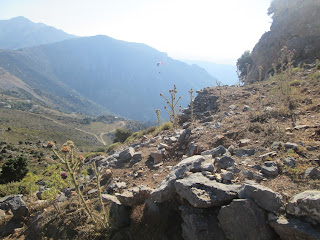 It was the very last day of our stay in Crete and we climbed
up a hillside to the Diktean Cave – suitably spectacular for the birthplace of
Zeus. After that, Nigel planned that we
would climb another mountain and visit Karfi, the melancholy site of the last refuge of the Minoans.
It was the very last day of our stay in Crete and we climbed
up a hillside to the Diktean Cave – suitably spectacular for the birthplace of
Zeus. After that, Nigel planned that we
would climb another mountain and visit Karfi, the melancholy site of the last refuge of the Minoans.
A fitting ending for our holiday.
The idea was to drive up a dirt track and park by a tiny
chapel on a higher plateau before making the ascent. Except that my leg was aching and I was sure
I couldn't make the 200m ascent. And the
walk had disappeared from the Lonely Planet website - had people had bad
experiences? Just how rough was the dirt road?
As we rested at the inn, Nigel and Pascoe went out on the
pretext of going to the shops. They returned
much later, enthused. They had explored
the first stretch of dirt road. Although
aware that I was unlikely to make it, I allowed myself to be persuaded. Not least because there was the prospect of
seeing the massive griffon vulture, with its wingspan of 2.8 metres.
In the evening light, the shadows of the mountains fell mauve. There was the comforting mellow sound of
sheep bells, the low croaking of ravens. Every so often, the breeze blew us the
savoury fragrance of wild thyme or
Dictean oregano.
All of this would have been enough by itself, and indeed, it
might have had to be for although Karfi has been called the Machu Pichu of Crete,
there is little now to see.
It was sad that the once great Minoans had been driven this last
mountain stronghold while the rest of Crete was under Mycenaean rule.
But what about the griffon vultures? As we climbed, we had
already twice been distracted by exciting birds of prey which turned out to be
buzzards.
But now, just skimming the horizon, I began to see something
else. A really large bird. I was never quick enough with my binoculars before
it dipped from view. As we gained the top of the pass the sightings became more
frequent. There seemed to be three of
the birds. Seeing some ravens flying
around them and dwarfed by them, I realised that we were looking at something
very large indeed. Finally I let myself
believe it.
'Vultures,' I yelled.
Soon, we were at the topmost plateau, and the giant birds
were using the thermals it produced in order to rise, so they would swoop in spectacularly
low and we could see their heads move as they checked us out.
“Nope - not carcases
yet,”
Then as they caught the air current, they would soar high away. Paragliders appeared, drifting through the
air and one curious vulture circled them.
'Can you imagine?' said Perran 'That would be so scary.'
Meanwhile, Carenza, followed by her brothers, climbed the
high limestone pinnacles which were beginning to flush apricot in the sunset,
getting even closer to the huge scavengers.
Nigel & I began to explore the tumbled walls of the ancient settlement,
overgrown with all manner of thorny and aromatic plants. Even so, it was hard to take our eyes off the
birds and it was remarkable how swiftly their vast wings carried them on the breeze
with scarcely ever a flap.
Finally, when the vultures were no longer visible and the youngsters
had descended to the ruins, we decided it was time to head back down to the
car.
But we threw one last look over our shoulders and there they
were, approaching along the flank of the mountain - a flock of seven vultures,
and heading in the opposite direction, just for scale, eight ravens.
It was our own personal fly-past.
And when we got back down to the inn and the internet, we
looked up a word we had never before needed to know –




No comments:
Post a Comment